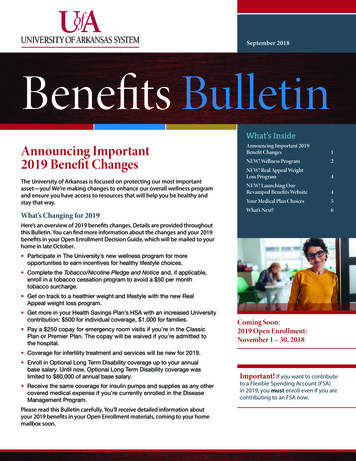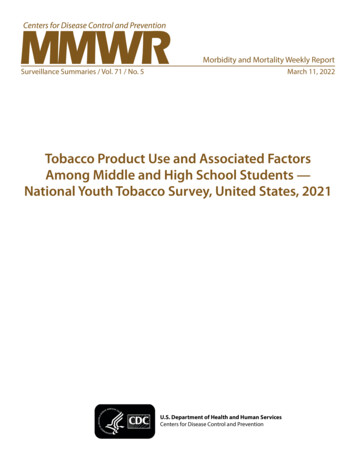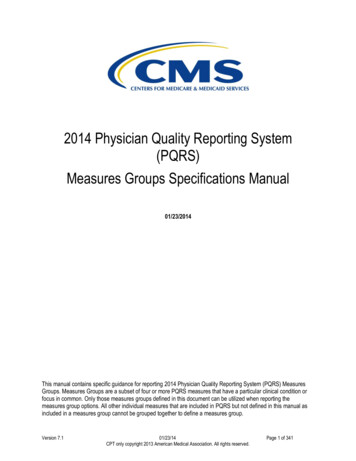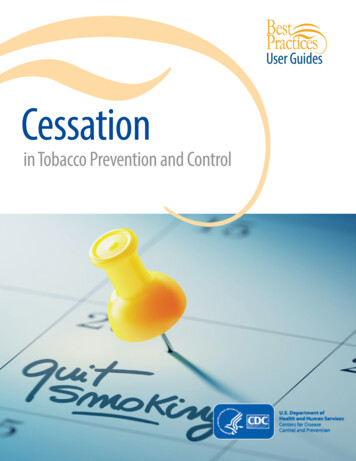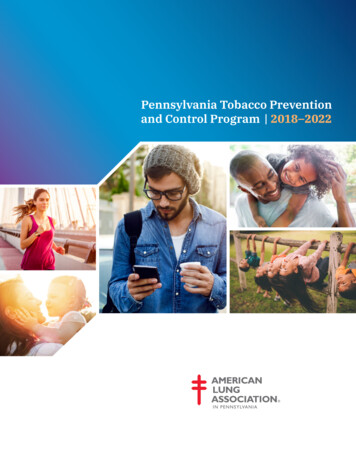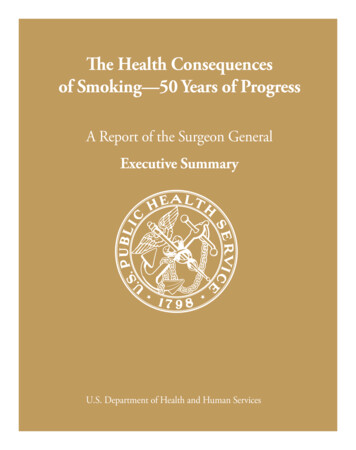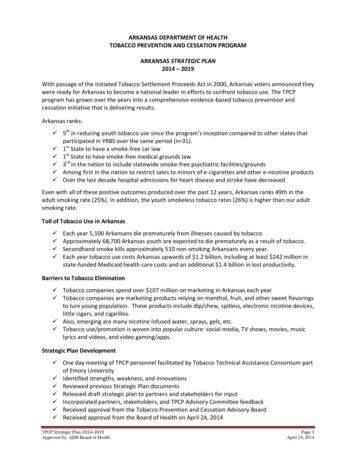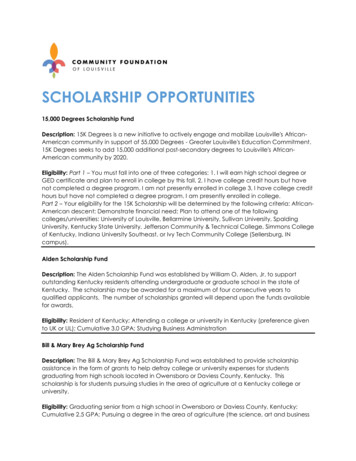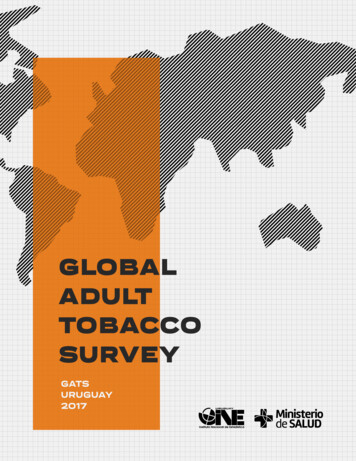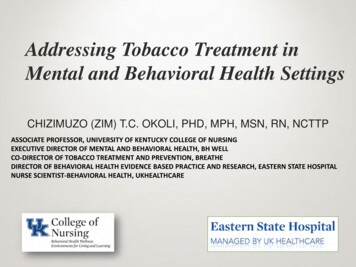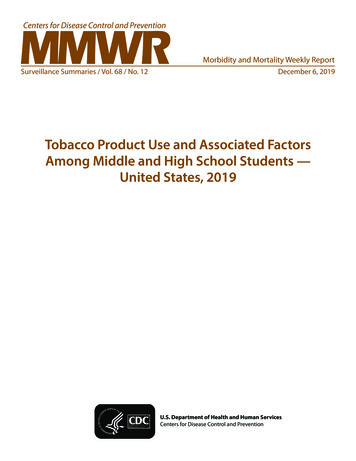
Transcription
Morbidity and Mortality Weekly ReportSurveillance Summaries / Vol. 68 / No. 12December 6, 2019Tobacco Product Use and Associated FactorsAmong Middle and High School Students —United States, 2019U.S. Department of Health and Human ServicesCenters for Disease Control and Prevention
Surveillance iscussion.8Limitations.9Conclusion. 10References. 10The MMWR series of publications is published by the Center for Surveillance, Epidemiology, and Laboratory Services, Centers for Disease Control and Prevention (CDC),U.S. Department of Health and Human Services, Atlanta, GA 30329-4027.Suggested citation: [Author names; first three, then et al., if more than six.] [Title]. MMWR Surveill Summ 2019;68(No. SS-#):[inclusive page numbers].Centers for Disease Control and PreventionRobert R. Redfield, MD, DirectorAnne Schuchat, MD, Principal Deputy DirectorChesley L. Richards, MD, MPH, Deputy Director for Public Health Science and SurveillanceRebecca Bunnell, PhD, MEd, Director, Office of ScienceBarbara Ellis, PhD, MS, Acting Director, Office of Science Quality, Office of ScienceMichael F. Iademarco, MD, MPH, Director, Center for Surveillance, Epidemiology, and Laboratory ServicesMMWR Editorial and Production Staff (Serials)Charlotte K. Kent, PhD, MPH, Editor in ChiefChristine G. Casey, MD, EditorMary Dott, MD, MPH, Online EditorTerisa F. Rutledge, Managing EditorDavid C. Johnson, Lead Technical Writer-EditorMarella Meadows, Project EditorMMWR Editorial BoardIleana Arias, PhDJay C. Butler, MDMatthew L. Boulton, MD, MPHVirginia A. Caine, MDKatherine Lyon Daniel, PhDMartha F. Boyd, Lead Visual Information SpecialistMaureen A. Leahy, Julia C. Martinroe,Stephen R. Spriggs, Tong Yang,Visual Information SpecialistsQuang M. Doan, MBA, Phyllis H. King,Terraye M. Starr, Moua Yang,Information Technology SpecialistsTimothy F. Jones, MD, ChairmanJonathan E. Fielding, MD, MPH, MBADavid W. Fleming, MDWilliam E. Halperin, MD, DrPH, MPHJewel Mullen, MD, MPH, MPAJeff Niederdeppe, PhDPatricia Quinlisk, MD, MPHStephen C. Redd, MDPatrick L. Remington, MD, MPHCarlos Roig, MS, MAWilliam Schaffner, MDMorgan Bobb Swanson, BS
Surveillance SummariesTobacco Product Use and Associated FactorsAmong Middle and High School Students — United States, 2019Teresa W. Wang, PhD1; Andrea S. Gentzke, PhD1; MeLisa R. Creamer, PhD1; Karen A. Cullen, PhD2; Enver Holder-Hayes, MPH2;Michael D. Sawdey, PhD2; Gabriella M. Anic, PhD2; David B. Portnoy, PhD2; Sean Hu, DrPH1; David M. Homa, PhD1; Ahmed Jamal, MBBS1;Linda J. Neff, PhD11Officeon Smoking and Health, National Center for Chronic Disease Prevention and Health Promotion, CDC2Center for Tobacco Products, Food and Drug Administration, Silver Spring, MarylandAbstractProblem/Condition: Tobacco use is the leading cause of preventable disease, disability, and death in the United States. Mosttobacco product use begins during adolescence. In recent years, tobacco products have evolved to include various smoked,smokeless, and electronic products.Period Covered: 2019.Description of System: The National Youth Tobacco Survey (NYTS) is an annual, cross-sectional, school-based, self-administeredsurvey of U.S. middle school (grades 6–8) and high school (grades 9–12) students. A three-stage cluster sampling procedureis used to generate a nationally representative sample of U.S. students attending public and private schools. NYTS is the onlynationally representative survey of U.S. middle and high school students that focuses exclusively on tobacco product use patternsand associated factors. NYTS is designed to provide national data on tobacco product use and has been conducted periodicallyduring 1999–2009 and annually since 2011. Data from NYTS are used to support the design, implementation, and evaluationof comprehensive tobacco use prevention and control programs and to inform tobacco regulatory activities. Since its inceptionin 1999 through 2018, NYTS had been conducted via paper and pencil questionnaires. In 2019, NYTS for the first time wasadministered in schools using electronic data collection methods. CDC’s Office on Smoking and Health, in collaboration with theU.S. Food and Drug Administration’s (FDA’s) Center for Tobacco Products, analyzed data from the 2019 NYTS to assess tobaccoproduct use patterns and associated factors among U.S. middle and high school students. Overall, 19,018 questionnaires werecompleted and weighted to represent approximately 27.0 million students. On the basis of self-reported grade level, this included8,837 middle school questionnaires (11.9 million students) and 10,097 high school questionnaires (15.0 million students); 84questionnaires with missing information on grade level were excluded from school-level analyses.Results: In 2019, an estimated 53.3% of high school students (8.0 million) and 24.3% of middle school students (2.9 million) reportedhaving ever tried a tobacco product. Current (past 30-day) use of a tobacco product (i.e., electronic cigarettes [e-cigarettes], cigarettes,cigars, smokeless tobacco, hookahs, pipe tobacco, and bidis [small brown cigarettes wrapped in a leaf ]) was reported by 31.2% ofhigh school students (4.7 million) and 12.5% of middle school students (1.5 million). E-cigarettes were the most commonly citedtobacco product currently used by 27.5% of high school students (4.1 million) and 10.5% of middle school students (1.2 million),followed in order by cigars, cigarettes, smokeless tobacco, hookahs, and pipe tobacco. Tobacco product use also varied by sex andrace/ethnicity. Among current users of each tobacco product, the prevalence of frequent tobacco product use (on 20 days of thepreceding 30 days) ranged from 16.8% of cigar smokers to 34.1% of smokeless tobacco product users. Among current users of eachindividual tobacco product, e-cigarettes were the most commonly used flavored tobacco product (68.8% of current e-cigarette users).Among students who reported ever having tried e-cigarettes, the three most commonly selected reasons for use were “I was curiousabout them” (55.3%), “friend or family member used them” (30.8%), and “they are available in flavors, such as mint, candy, fruit,or chocolate” (22.4%). Among never users of each individual tobacco product, curiosity and susceptibility (a construct that canhelp to identify future tobacco product experimentation or use) was highest for e-cigarettes (39.1% and 45.0%, respectively) andcigarettes (37.0% and 45.9%, respectively). Overall, 86.3% of students who reported contact with an assessed potential source oftobacco product advertisements or promotions (going to a convenience store, supermarket, or gas station; using the Internet; watchingtelevision or streaming services or going to the movies; or readingnewspapers or magazines) reported exposure to marketing for anyCorresponding author: Teresa W. Wang, PhD, Office on Smoking andtobacco product; 69.3% reported exposure to e-cigarette marketingHealth, National Center for Chronic Disease Prevention and Healthand 81.7% reported exposure to marketing for cigarettes or otherPromotion, CDC. Telephone: 770-488-5493; E-mail twwang@cdc.gov.tobacco products. Among all students, perceiving no harm or littleUS Department of Health and Human Services/Centers for Disease Control and PreventionMMWR / December 6, 2019 / Vol. 68 / No. 121
Surveillance Summariesharm from intermittent tobacco product use (use on some days but not every day) was 28.2% for e-cigarettes, 16.4% for hookahs,11.5% for smokeless tobacco products, and 9.5% for cigarettes. Among current users of any tobacco product, 24.7% reportedexperiencing cravings to use tobacco products during the past 30 days and 13.7% reported wanting to use a tobacco product within30 minutes of waking. Moreover, 57.8% of current tobacco product users reported they were seriously thinking about quitting the useof all tobacco products and 57.5% reported they had stopped using all tobacco products for 1 day because they were trying to quit.Interpretation: In 2019, approximately one in four youths (23.0%) had used a tobacco product during the past 30 days. By schoollevel, this represented approximately three in 10 high school students (31.2%) and approximately one in eight middle schoolstudents (12.5%). Since 2014, e-cigarettes have been the most commonly used tobacco product among youths. Importantly,more than half of current youth tobacco product users reported seriously thinking about quitting all tobacco products in 2019.However, established factors of use and initiation, including the availability of flavors, exposure to tobacco product marketing,curiosity and susceptibility, and misperceptions about harm from tobacco product use, remained prevalent in 2019 and continueto promote tobacco product use among youths.Public Health Action: The continued monitoring of all forms of youth tobacco product use and associated factors throughsurveillance efforts including NYTS is important to the development of public health policy and action at national, state, andcommunity levels. Everyone, including public health professionals, health care providers, policymakers, educators, parents, andothers who influence youths, can help protect youths from the harms of all tobacco products. In addition, the comprehensive andsustained implementation of evidence-based tobacco control strategies, combined with FDA’s regulation of tobacco products, isimportant for reducing all forms of tobacco product use among U.S. youths.IntroductionMethodsTobacco product use is the leading cause of preventabledisease, disability, and death in the United States (1). Preventingtobacco product use among youths is critical to decreasingmorbidity and mortality because nearly all tobacco product usebegins during youth or young adulthood; approximately ninein 10 adult cigarette smokers start before age 18 years (1–3). Inrecent years, tobacco products have evolved to include varioussmoked, smokeless, and electronic products.The National Youth Tobacco Survey (NYTS), conductedperiodically during 1999–2009 and annually since 2011,provides national data on estimates of tobacco product useto support the design, implementation, and evaluation ofcomprehensive youth tobacco prevention and control programsand to inform tobacco regulatory activities in the United States(4). NYTS is the only nationally representative survey of U.S.middle school (grades 6–8) and high school (grades 9–12)students that focuses exclusively on tobacco product use andassociated factors.This report uses findings from the 2019 NYTS to describe theprevalence of youth tobacco product use and selected associatedfactors, including flavored tobacco product use, reasons foruse, exposure to tobacco product marketing, curiosity andsusceptibility, harm perceptions, urges to use tobacco products,and quitting behaviors. These findings can be used by publichealth professionals, health care providers, policymakers,educators, parents, and others who influence youths to preventand reduce tobacco product use among U.S. youths.National Youth Tobacco SurveySampling Procedures2MMWR / December 6, 2019 / Vol. 68 / No. 12NYTS is a cross-sectional, school-based, self-administeredsurvey of U.S. middle and high school students (4). The 2019NYTS sampling frame consisted of all regular public andprivate schools with students enrolled in grades 6–12 in the 50U.S. states and the District of Columbia. The sampling framecomprised data obtained from Market Data Retrieval (5) andthe National Center for Education Statistics (6,7). Alternativeschools, special education schools, U.S. Department of Defense–operated schools, Bureau of Indian Affairs schools, vocationalschools, and schools with a combined total of 40 students ingrades 6–12 were excluded. Participation in NYTS was voluntaryat both the school and student levels; parental consent andstudent assent were required for NYTS participation.The 2019 NYTS used a stratified, three-stage cluster sampledesign. Sampling procedures were probabilistic and conductedwithout replacement at all stages. Primary sampling units(PSUs), defined as individual counties, portions of a county,or groups of counties, were randomly selected within eachstratum. PSUs were organized into 16 strata on the basis ofurban or rural location and racial or ethnic group. Secondarysampling units, defined as schools or linked schools, wererandomly selected within each PSU. The third and finalsampling stage consisted of randomly selected classes. Allstudents in the selected classes were eligible to participate inthe survey; however, students who were unable to completethe questionnaire without special assistance were excluded.US Department of Health and Human Services/Centers for Disease Control and Prevention
Surveillance SummariesData Collection and ProcessingAnalysesSince its inception in 1999, NYTS had been conductedvia paper and pencil questionnaires. In 2019, NYTS forthe first time was administered in schools using electronicdata collection methods. Participants were provided with atablet computer (Samsung Galaxy Tab A) to complete thesurvey. Data were collected offline using a programmedsurvey application, and a single class period of approximately35–45 minutes was allotted to complete the survey. Surveyadministrators later established secure WiFi connections tosynchronize all locally stored tablet data to a central repositoryvia encrypted transmissions. Absent students and wholeclasses unavailable on the day of survey administration couldparticipate in make-up surveys using a web-based version ofthe questionnaire programmed to mimic the tablet-basedapplication. The 2019 NYTS was reviewed and approved bythe Office of Management and Budget, the contracted datacollectors’ institutional review board (IRB), and CDC’s IRB.The 2019 questionnaire contained 104 questions coveringdemographic information, tobacco product use, knowledgeand attitudes about tobacco products, protobacco andantitobacco media and advertising, access to tobacco products,nicotine dependence, cessation attempts, secondhand smokeand secondhand aerosol exposure, harm perceptions, exposureto tobacco product health warnings, and other tobaccorelated topics. Tobacco product images and descriptions weredisplayed in a preamble before each tobacco product–specificsection. Respondents did not answer all questions becauseof questionnaire skip patterns (e.g., nonusers of e-cigarettesskipped questions specific to current use of e-cigarettes) andthe voluntary nature of the survey.Survey administration occurred from February 15, 2019,to May 24, 2019. The final sample consisted of 325 schools,of which 251 participated (school response rate: 77.2%).A total of 19,018 student questionnaires were completed(17,197 tablet based and 1,821 web based) out of a sample of22,153 students (student response rate: 85.8%). The overallresponse rate, defined as the product of the school-level andstudent-level response rates, was 66.3%. After exclusion ofoutliers, the average survey completion time was approximately12.5 minutes. A weighting factor was applied to each studentrecord to adjust for nonresponse and for varying probabilitiesof selection. Weights were adjusted to ensure that the weightedproportions of students in each grade matched nationalpopulation proportions. Additional information on the NYTSsampling design, recruitment procedures, and data weighting isavailable (https://www.cdc.gov/tobacco/data statistics/surveys/nyts/index.htm).Statistical analyses were conducted using SAS-callableSUDAAN software (version 11.0.1; RTI International) toaccount for the complex sampling design (8). Weightedprevalence estimates and 95% confidence intervals werecomputed for all measures, and population totals were estimatedfrom probability weights. Overall, 19,018 questionnaires wereweighted to represent approximately 27.0 million students. Onthe basis of self-reported grade level, this included 8,837 middleschool questionnaires (approximately 11.9 million students)and 10,097 high school questionnaires (approximately15.0 million students); 84 questionnaires with missinginformation on grade level were excluded from school-levelanalyses. When applicable, estimates were determined overalland by self-reported sex (male or female), race and ethnicity(non-Hispanic white, non-Hispanic black, Hispanic, ornon-Hispanic other), and school level (middle school orhigh school). Results with unweighted denominators 50 ora relative standard error 30% are not shown.MeasuresEver and Current Tobacco Product UseEver and current (past 30-day) use of seven tobacco productswas assessed. These products were e-cigarettes, cigarettes,cigars (cigars, little cigars, and cigarillos), smokeless tobacco(chewing tobacco, snuff, dip, snus, and dissolvable tobacco),hookahs, pipe tobacco, and bidis (small brown cigaretteswrapped in a leaf ). Ever use was defined as ever trying eachrespective product, and current use was defined as using eachrespective product on 1 day during the past 30 days. Anytobacco product use was defined as use of one or more of theseven tobacco products. Use of two or more tobacco producttypes was defined as use of two or more of the seven tobaccoproducts. Any combustible tobacco product use was definedas use of one or more of the following: cigarettes, cigars,hookahs, pipe tobacco, and bidis. Current tobacco productuse combinations also were assessed.Frequency of Tobacco Product UseThe 2019 NYTS included questions to assess the frequencyof tobacco product use among current users of the followingtobacco products: e-cigarettes, cigarettes, cigars, smokelesstobacco (chewing tobacco, snuff, or dip), and hookahs.Respondents were asked, “During the past 30 days, on howmany days did you (use e-cigarettes; smoke cigarettes; smokecigars, cigarillos, or little cigars; use chewing tobacco, snuff, ordip; or smoke tobacco in a hookah or water pipe)?” Responseoptions ranged between 0 and 30 days. Consistent with previousUS Department of Health and Human Services/Centers for Disease Control and PreventionMMWR / December 6, 2019 / Vol. 68 / No. 123
Surveillance Summariesliterature, response options were categorized as 1–5 days,6–19 days, and 20–30 days for analysis (9). Frequent use wasdefined as using a product on 20 days of the past 30 days.Flavored Tobacco Product UseFlavored tobacco product use was determined by theresponse to the question, “Which of the following tobaccoproducts that you used in the past 30 days were flavored totaste like menthol (mint), alcohol (wine or cognac), candy,fruit, chocolate, or other sweets?” Participants could selectfrom a list of options to indicate the flavored tobacco productor products they had used. Among students who reportedcurrent use of each respective product, those who selectedthe flavored product were categorized as a flavored productuser. Flavored (menthol) cigarette smoking, specifically, wasascertained from responses to two questions: 1) “During thepast 30 days, were the cigarettes that you usually smokedmenthol?” and 2) “During the past 30 days, what brand ofcigarettes did you usually smoke?” Among current cigarettesmokers, those reporting “yes” to the menthol question or whoreported “Newport” or “Kool” as the usual cigarette brand werecategorized as flavored (menthol) cigarette smokers.Reasons for E-Cigarette UseReasons for e-cigarettes use were assessed by asking ever andcurrent e-cigarette users, “What are the reasons why you haveused electronic cigarettes or e-cigarettes?” Respondents couldselect one or more of 12 specified reasons. Those who indicated“I used them for some other reason” could specify their reasonwith a write-in response; analysis of these write-in responses(n 642) was not included in this report. Reasons for use ofother tobacco products were not assessed in the 2019 NYTS.Exposure to Tobacco Product MarketingExposure to tobacco product marketing (advertisements orpromotions) were assessed for four sources: retail stores; Internet;television, streaming sources, or movies; and newspapers ormagazines. Exposure was assessed separately for e-cigarettesand cigarettes or other tobacco products. Participants wereasked, “When you (are using the Internet; read newspapersor magazines; go to a convenience store, supermarket, or gasstation; watch television or streaming services [such as Netflix,Hulu, or Amazon Prime], or go to the movies), how often doyou see ads or promotions for (e-cigarettes; cigarettes or othertobacco products)?” Respondents were categorized as exposedif they responded “sometimes,” “most of the time,” or “always”or unexposed if they responded “never” or “rarely.” Persons whoreported “I never go to a convenience stores, supermarket, orgas station,” “I do not use the Internet,” “I do not watch TVor streaming services or go to the movies,” or “I do not readnewspapers or magazines” were set to missing.4MMWR / December 6, 2019 / Vol. 68 / No. 12Curiosity and SusceptibilityThe 2019 NYTS included questions to assess curiosityabout and susceptibility to the following tobacco products:e-cigarettes, cigarettes, cigars, hookahs, and smokeless tobaccoproducts (chewing tobacco, snuff, or dip). For curiosity,respondents were asked, “Have you ever been curious about(using an e-cigarette; smoking a cigarette; smoking a cigar,cigarillo, or little cigar; using chewing tobacco, snuff, or dip; orsmoking tobacco in a hookah or water pipe)?” To capture anylevel of curiosity, responses were recoded as curious (definitelyyes, probably yes, or probably not) and not curious (definitelynot). For each of these products, three questions assessedsusceptibility: 1) “Do you think that you will try (an e-cigarette;a cigarette; a cigar, cigarillo, or little cigar; chewing tobacco,snuff, or dip; or smoking tobacco in a hookah or water pipe)soon?”; 2) “Do you think you will (use an e-cigarette; smokea cigarette; smoke a cigar, cigarillo, or little cigar; use chewingtobacco, snuff, or dip; or smoke tobacco in a hookah or waterpipe) in the next year?”; and 3) “If one of your best friendswere to offer you (an e-cigarette; cigarette; cigar, cigarillo, orlittle cigar; chewing tobacco, snuff, or dip; or a hookah orwater pipe with tobacco), would you (use; smoke; or try) it?”Consistent with previous literature, to differentiate betweencommitted never tobacco product users from susceptibletobacco product users (10), susceptibility for each productwas defined as a response other than “definitely not” to anyof the three susceptibility questions or the curiosity question.Curiosity and susceptibility were assessed among respectivenever users of each respective tobacco product.Harm PerceptionsThe 2019 NYTS included questions to assess harmperceptions of the following tobacco products: e-cigarettes,cigarettes, smokeless tobacco (chewing, snuff, dip, or snus),and hookahs. All respondents were asked, “How much do youthink people harm themselves when they (smoke cigarettes; usechewing tobacco, snuff, dip, or snus; use e-cigarettes; or smoketobacco in a hookah or water pipe) some days but not everyday?” Response options included “no harm,” “little harm,”“some harm,” and “a lot of harm.”Urges to Use Tobacco ProductsCurrent users of any tobacco product were asked two questions:1) “During the past 30 days, have you had a strong craving or feltlike you really needed to use a tobacco product of any kind?” (withresponse options of yes or no) and 2) “How soon after you wakedo you want to use a tobacco product?” (with response optionsof “I do not want to use tobacco products,” within 5 minutes,from 6 to 30 minutes, from 30 minutes to 1 hour, after 1 hourbut 24 hours, and “I rarely want to use tobacco products”).US Department of Health and Human Services/Centers for Disease Control and Prevention
Surveillance SummariesConsistent with previous literature (11), responses to the secondquestion were dichotomized according to whether the respondentwanted to use a tobacco product within the first 30 minutes ofwakening (yes or no).Quitting BehaviorsCurrent users of any tobacco product were asked twoquestions: 1) “Are you seriously thinking about quitting theuse of all tobacco products?” (with response options of “yes,during the next 6 months”; “yes, during the next 12 months”;“yes, but not during the next 12 months”; and “no, I am notthinking about quitting the use of all tobacco products”) and2) “During the past 12 months, how many times have youstopped using all tobacco products for one day or longer,because you were trying to quit tobacco products for good?”(with response options of one time, two times, three to fivetimes, six to nine times, 10 times, and “I did not try to quitduring the past 12 months”). Responses were dichotomized bywhether the respondent was seriously thinking about quitting(yes or no) or made past-year quit attempts (more than onetime or did not try quitting).ResultsEver Tobacco Product UseIn 2019, 40.5% of U.S. middle and high school students(10.9 million) reported having ever tried a tobacco product(Table 1). Among ever tobacco product users, 58.5% had evertried a combustible tobacco product and 53.8% had ever triedtwo or more tobacco product types. Overall, 53.3% of highschool students (8.0 million) and 24.3% of middle schoolstudents (2.9 million) reported ever using any tobacco product.E-cigarettes were the most commonly ever used tobaccoproduct among U.S middle and high school students overall(35.0%; 9.4 million), among females (35.4%) and males(35.7%), and among non-Hispanic whites (38.2%), Hispanics(35.4%), non-Hispanic blacks (27.0%), and non-Hispanics ofother races (24.4%).(2.6%), and pipe tobacco ( 1.0%) (Figure 1). Among currenttobacco product users, 55.5% reported use of e-cigarettesonly. Moreover, e-cigarettes were the most commonly usedproduct in combination with other tobacco products; amongstudents who reported current use of two or more tobaccoproducts, 17.2% reported current use of e-cigarettes and cigars,13.3% reported current use of e-cigarettes and cigarettes,and 9.8% reported current use of e-cigarettes and smokelesstobacco (Figure 2).Among high school students, 31.2% (4.7 million)reported current use of any tobacco product. Among thesecurrent tobacco product users, 38.5% currently used anycombustible tobacco product and 34.6% reported currentuse of two or more tobacco product types. Among highschool students, e-cigarettes were the most commonly usedtobacco product (27.5%), followed by cigars (7.6%), cigarettes(5.8%), smokeless tobacco (4.8%), hookahs (3.4%), andpipe tobacco (1.1%).Among middle school students, 12.5% (1.5 million)reported current use of any tobacco product. Among thesecurrent tobacco product users, 38.4% used any combustibletobacco product and 32.0% reported current use of two ormore tobacco product types. Among middle school students,e-cigarettes were the most commonly used tobacco product(10.5%), followed by cigarettes and cigars (both 2.3%),smokeless tobacco (1.8%), and hookahs (1.6%).Frequency of Tobacco Product UseAmong middle and high school students who were currentusers of each product, the prevalence of frequent tobaccoproduct use ( 20 days of the past 30 days) was 34.1% ofsmokeless tobacco users (270,000), 30.4% of e-cigaretteusers (1.6 million), 28.9% of cigarette smokers (330,000),18.6% of hookah smokers (120,000), and 16.8% of cigarsmokers (240,000) (Table 3). Most current tobacco productusers reported using tobacco products on 1–5 days of the past30 days, including 69.1% of hookah smokers, 68.7% of cigarsmokers, 55.9% of cigarette smokers, 50.8% of e-cigaretteusers, and 49.3% of smokeless tobacco users.Current Tobacco Product UseOverall, 23.0% of middle and high school students(6.2 million) reported current (past 30-day) use of any tobaccoproduct (Table 2). Among current tobacco product users,38.3% currently used any combustible tobacco product and33.9% currently used two or more tobacco product types.E-cigarettes were the most commonly used tobacco productoverall (20.0%; 5.4 million), followed by cigars (5.3%),cigarettes (4.3%), smokeless tobacco (3.5%), hookahsFlavored Tobacco Product UseIn 2019, 69.6% (4.3 million) of middle and high schoolstudents who currently used tobacco products reported using atleast one flavored tobacco product. E-cigarettes were the mostcommonly used flavored tobacco product (68.8% of currente-cigarette users; 3.7 million). The proportion of other currenttobacco product users who reported flavored product use was48.0% for smokeless tobacco, 46.7% for cigarettes (mentholonly), 41.9% for cigars, 31.4% for pipe tobacco, and 31.2%US Department of Health and Human Services/Centers for Disease Control and PreventionMMWR / December 6, 2019 / Vol. 68 / No. 125
Surveillance SummariesFIGURE 1. Percentage of middle and high school students who currently use any tobacco product,* any combustible tobacco product,†two or more tobacco product types,§ and selected tobacco products, by school level¶ and overall — National Youth Tobacco Survey,United States, 2019100Any tobacco productAny combustible tobacco productTwo or more tobacco product typesE-cigarettesCigarettesCigarsSmo
and associated factors. NYTS is designed to provide national data on tobacco product use and has been conducted periodically during 1999-2009 and annually since 2011. Data from NYTS are used to support the design, implementation, and evaluation of comprehensive tobacco use prevention and control programs and to inform tobacco regulatory .
